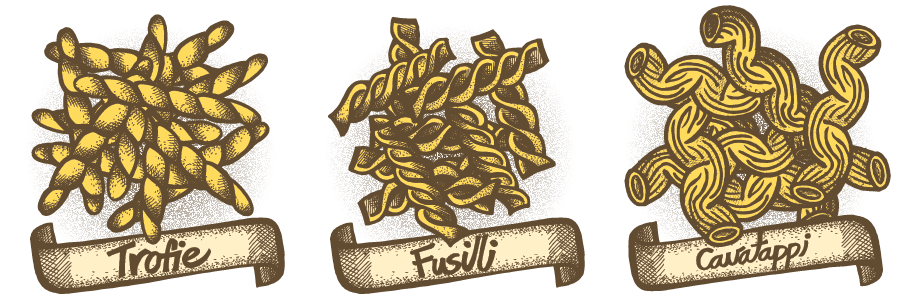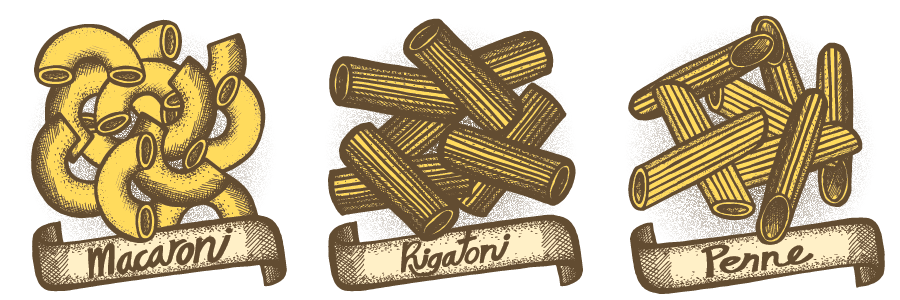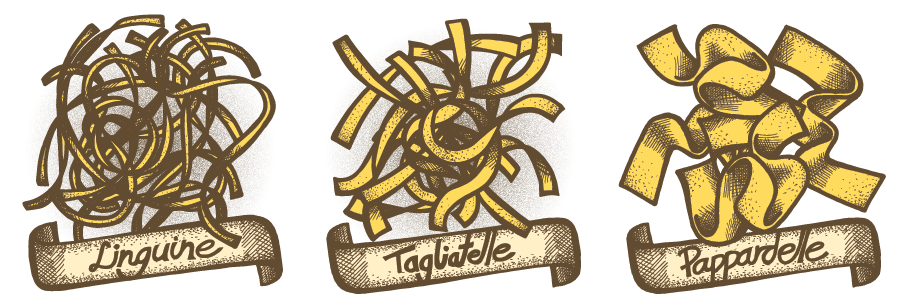A guide to getting fancier than fettuccine
We’re all familiar with pasta shapes like spaghetti, macaroni and fettuccine. There’s probably at least one of these in your kitchen right now.
But are they the right shape for the dish you’re making? Rosario Caputo (Culinary Arts ’05) could tell you. The former co-owner of Cibo Bistro, an Italian restaurant he ran in downtown Edmonton, is now preparing to open Impasto Lab to teach people how to make pasta and properly use it.
Shapes are not just for aesthetics. They can enhance the eating experience. For example, Caputo explains, ragu with thicker pieces of meat might not stick between the ridges of corkscrew shaped pasta. But pesto will. And, Caputo adds, “A long noodle will twirl a richer sauce and chunks of meat together so that they make an impression on your memory.”
Whether it’s homemade or store-bought pasta, there is variety to be had. Caputo offers a guide on how to properly use some of those classic shapes and also introduces less familiar ones he thinks should have a place alongside those staples on your pantry shelves.
For light or butter sauces

“This is the thinnest and most delicate of the noodles,” Caputo explains. Because it is so thin, it will get lost in heavier sauces like ragus. But it’s perfect for simple sauces, such as a butter-based sauce. In a pinch, you can substitute spaghetti for capellini but never the other way around. “There’s a little more dimension to spaghetti and a little more bite.”

Similar to ravioli, Agnolotti is made with a single piece of pasta folded over like a pillow (ravioli are made with two pieces of pasta). It traditionally has a meat filling with a little nook for the sauce. Caputo describes a popular variation: mix veal, vegetables and basil with a little onion and garlic. Sautée this, finish with a sharp cheese and make it into a paste. Fold this into the pasta and paired with a butter or sage sauce.
For pestos

Trofie, fusilli and cavatappi are all corkscrew designs, which allows for sauces to get into the pasta’s crevices. They’re traditionally served with pesto genovese, made with basil, toasted pine nuts, pecorino cheese or parmigiana reggiano, and garlic.
“Trofie comes from the far north in Italy and is made by hand,” says Caputo. Pasta makers roll a small piece of dough in a diagonal fashion. “You’ll get a corkscrew swirl and it just coddles the pesto very well.”

Farfalle is known for its bowtie shape. Similar to the corkscrews, farfalle is best for pesto sauces, tomato sauces and cream sauces. It has pockets where the bow meets in the middle to cup the sauce.

This coiled shape is similar to a long fusilli, but it’s a thicker ribbon. Caputo commonly pairs it with pesto trapanese, made with fresh tomato, toasted almond, parsley, basil and garlic, all fresh. It’s earthy, rich yet light. Cook the noodles and toss with the pesto.
For tomato based sauces

These tubular shapes are great for tomatoes or rustic tomato bases, and pair well with chunks of meat instead of ground meat. Caputo recommends trying a sauce with olives, capers, fresh tomatoes or mushrooms. The tubes get coated with sauce on the outside while additional sauce, meat and vegetables makes its way into the middle of the tube.

Orecchiette is one of Caputo’s favourite pasta shapes – one he thinks more people should know about. “We went to Bari [in southern Italy] and sat on the street where they just made the noodles for 15 hours a day,” he says. “There’s a deeper appreciation and respect for the shape when you’re making it.”
Orecchiette are little cups in the shape of an ear that might be paired with greens, like rapini or broccoli rabe, and anchovies and breadcrumbs. Alternatively, they’re great for sausage and tomato, with soft, melted mozza. Use smaller cuts of everything so the shape can hold it all in.

Caputo says that as you go from north to south in Italy, the richness of the food changes. This classic noodle is made with just flour and water in the south, where eggs are not as common in pasta. The outer ridges hold the sauce, as do the crevices in the centre. It’s commonly paired with fresh tomatoes and finished with sharp, salty cheese.
For soup

These shapes are little rings filled with either meat or cheese. It can be served with a light tomato or butter sauce, but is also perfect in a brodo, a rich and flavourful broth.
For ragu

From the area around and including Rome, bucatini is a hollow, thick spaghetti that gets coated on the outside as well as filled with sauce. A classic dish is carbonara, with egg, pepper and guanciale, or cured pork.
“Bucatini is a thicker spaghetti and can be cooked like spaghetti,” Caputo says. “If it were a full thick noodle, it would take a little longer, but with the hole in the middle, it’s the same cooking time as spaghetti.”

Linguine is common along the Amalfi Coast, Caputo says. In pairing ingredients with noodles, “Lots of seaside towns will use what is nearest to them,” he adds. In this case, that’s clams. “We found that spaghetti en vongole and linguine en vongole are very common in that area.”
Tagliatelle, from the northern Emilia-Romagna region, is the perfect accompaniment for a ragu bolognese or a sauce with finely ground meats. Pork, veal and chicken liver are all popular meats for a ragu. The ragu sauce is slowly simmered for hours with sofrito (a mix of carrots, celery and onion). Tagliatelle is perfect for hearty sauces because the thicker noodles won’t be overwhelmed by the sauce.
Pappardelle is from Tuscany, in central Italy, and is perfect for chunks of meat. The wider noodle holds everything together and the meat sauce gets wrapped around the noodle. “You get that thick noodle that coddles the chunks of meat and everything with it,” says Caputo.
All these noodles are great substitutions for spaghetti and fettuccine.
The five shapes never to be without
If homecooks want to have a pasta shape handy that will suit almost any dish, which would they be? Theseare pasta maker Rosario Caputo’s top five:
- Spaghetti
- Bucatini
- Rigatoni
- Orechiette
- Linguine